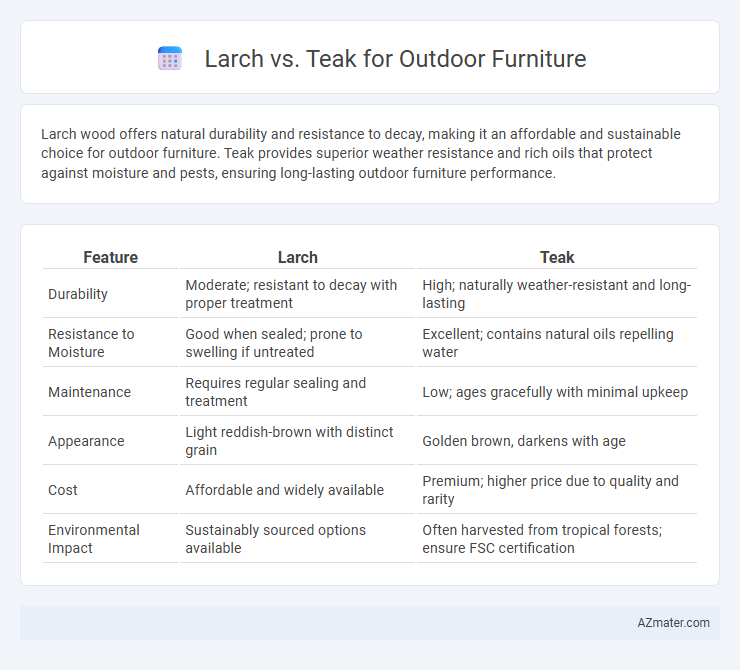Larch wood offers natural durability and resistance to decay, making it an affordable and sustainable choice for outdoor furniture. Teak provides superior weather resistance and rich oils that protect against moisture and pests, ensuring long-lasting outdoor furniture performance.
Table of Comparison
| Feature | Larch | Teak |
|---|---|---|
| Durability | Moderate; resistant to decay with proper treatment | High; naturally weather-resistant and long-lasting |
| Resistance to Moisture | Good when sealed; prone to swelling if untreated | Excellent; contains natural oils repelling water |
| Maintenance | Requires regular sealing and treatment | Low; ages gracefully with minimal upkeep |
| Appearance | Light reddish-brown with distinct grain | Golden brown, darkens with age |
| Cost | Affordable and widely available | Premium; higher price due to quality and rarity |
| Environmental Impact | Sustainably sourced options available | Often harvested from tropical forests; ensure FSC certification |
Introduction to Larch and Teak
Larch wood, known for its exceptional durability and natural resistance to decay, is a favored choice for outdoor furniture in colder climates due to its ability to withstand moisture and cold temperatures. Teak, a tropical hardwood prized for its rich golden-brown color and high oil content, offers superior water resistance and longevity, making it ideal for outdoor settings with intense sun exposure and humidity. Both larch and teak provide robust structural integrity and aesthetic appeal, yet their distinct environmental adaptations and maintenance needs influence selection for outdoor furniture projects.
Wood Origins and Sustainability
Larch wood, derived primarily from European species such as Larix decidua, is renowned for its natural durability and rapid growth, making it a sustainable choice for outdoor furniture. Teak, sourced mainly from the tropical regions of Southeast Asia, particularly Tectona grandis, is highly valued for its exceptional weather resistance but faces sustainability concerns due to overharvesting and slower growth cycles. Choosing larch offers a more eco-friendly option with renewable attributes, while sustainably certified teak can provide long-lasting performance when sourced responsibly.
Appearance and Grain Comparison
Larch wood features a warm, golden hue with pronounced knots and a coarse, straight grain that adds rustic charm to outdoor furniture. Teak displays a rich, golden-brown color that deepens over time, characterized by a smooth, tight, and straight grain pattern contributing to its luxurious, elegant look. The visual contrast between larch's rugged texture and teak's refined grain makes larch ideal for casual, natural settings, while teak suits sophisticated, upscale outdoor environments.
Durability in Outdoor Conditions
Larch wood offers strong resistance to decay and insect damage due to its high resin content, making it a durable choice for outdoor furniture in moderate climates. Teak surpasses many woods in durability with its dense grain, natural oils, and silica content that provide exceptional weather resistance and protection against moisture, rot, and UV damage. For long-lasting outdoor furniture, teak remains the superior option, especially in harsh environments where prolonged exposure to sun, rain, and humidity are concerns.
Resistance to Rot and Insects
Larch wood offers moderate resistance to rot and insect damage due to its natural resin content, making it suitable for outdoor furniture in less humid environments. Teak wood is highly resistant to rot and insect infestation because of its dense grain and natural oils, providing superior durability in harsh outdoor conditions. Choosing teak ensures longer-lasting outdoor furniture with minimal maintenance compared to larch.
Maintenance and Care Requirements
Larch wood requires regular sealing and varnishing to maintain its natural resistance to decay and moisture, making routine maintenance essential for longevity in outdoor furniture applications. Teak's high natural oil content allows it to withstand weather elements with minimal upkeep, often only needing periodic cleaning and occasional oiling to preserve its rich color and structural integrity. Both woods benefit from protective finishes, but teak offers a more durable, low-maintenance option, while larch demands more attentive care to prevent cracking and warping over time.
Cost and Availability
Larch wood offers a cost-effective option for outdoor furniture due to its widespread availability in Northern Europe and moderate pricing compared to other hardwoods. Teak, prized for its durability and natural oils, commands a higher market price and is sourced mainly from Southeast Asia, making it less readily available and more expensive. Choosing between Larch and Teak hinges on budget constraints and the willingness to invest in premium materials with long-term weather resistance.
Environmental Impact
Larch wood, known for its natural durability and fast growth, offers a more sustainable option for outdoor furniture compared to teak, which is often harvested from slow-growing tropical forests, raising deforestation concerns. The carbon footprint of larch is lower due to its regional availability and less intensive processing requirements, while teak's demand contributes to habitat loss and biodiversity decline in Southeast Asia. Choosing larch supports responsible forestry management and reduces environmental impact associated with long-distance transportation and illegal logging linked to teak.
Best Uses for Outdoor Furniture
Larch wood, known for its natural durability and resistance to moisture, is ideal for outdoor furniture exposed to varying weather conditions, making it suitable for garden benches, decks, and pergolas. Teak, with its high oil content and dense grain, offers superior resistance to rot, insects, and UV damage, making it the best choice for luxury outdoor furniture such as dining sets and loungers that require long-lasting strength and minimal maintenance. Both woods provide excellent weather resistance, but teak's premium qualities make it preferred for high-end applications, while larch balances cost and durability for more rustic or budget-friendly outdoor pieces.
Larch vs Teak: Which Should You Choose?
Larch wood offers excellent durability and natural resistance to rot, making it a cost-effective and sustainable choice for outdoor furniture. Teak is renowned for its superior weather resistance, rich golden color, and high oil content, which protects it from moisture and pests, justifying its premium price. For long-lasting, low-maintenance furniture with natural beauty, teak is ideal, while larch suits buyers seeking affordability without sacrificing strength and outdoor endurance.

Infographic: Larch vs Teak for Outdoor Furniture
 azmater.com
azmater.com